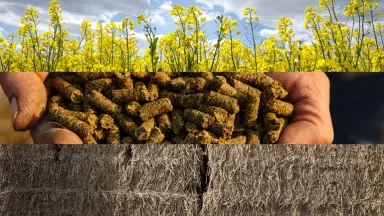
Agriculture, agri-food, forestry and bio-economy : overview of actions to adress climate change chalenges
Partager la page
Published two months before the opening of COP24, the latest report of the Intergovernmental Panel on Climate Change (IPCC) highlights the urgent need to limit global warming to 1.5°C. To this end, France has set itself the objective of achieving carbon neutrality by 2050. The Ministry of Agriculture and Food publishes a document that explains how agriculture, forestry and the bio-economy are playing a major role in the fight against climate change.
An IPCC special report dedicated to « the impacts of global warming of 1.5°C above pre-industrial levels and related global greenhouse gas emission pathways, in the context of strengthening the global response to the threat of climate change, sustainable development, and efforts to eradicate poverty », has been published two months before the opening of COP24. It had been requested by COP 21, in parallel with the adoption of the Paris Agreement.
Based on more than 6,000 scientific studies, this report is unequivocal about the magnitude of the threat and the urgency for action. The IPCC believes that it is still possible to limit this temperature increase to 1.5°C and limit the damage to humans and their environment, subject to determined public policies and properly directed investments.
Achieving carbon neutrality by 2050
In the 2017 Climate Plan, France set itself the objective of achieving carbon neutrality by 2050. This carbon neutrality is understood as the achievement of a balance between greenhouse gas emissions and anthropogenic removals (forests, grasslands, agricultural soils, wetlands, etc.). To do this, it is necessary for the energy system to evolve so that the energies consumed on French territory no longer emit greenhouse gases, but it is also essential to reduce emissions of other greenhouse gases such as methane (CH4) or nitrous oxide (N2O) and to offset the last residual emissions by carbon sequestration. Agriculture is largely concerned by all these issues.
To take action, the government is using The national Low Carbon Strategy (SNBC) announced on 27 November by the Minister in charge of environment. This Low Carbon Strategy is divided into 7 sectors of activity: energy production, buildings, transport, agriculture, industry, waste, forests and carbon sinks.
On the occasion of COP 24, the Ministry of Agriculture and Food is publishingthe Overview of French climate actions for agriculture, agrifood, forestry and the bio-economy. This document shows the diversity of its actions and shows their coherence and how they support economic and environmental performance.
Agriculture, forestry and the bio-economy are widely present in the low-carbon strategy through actions, often designed, in the first instance, to meet other objectives, and which can enter into synergy with other public policies or international negotiations led by the Government.
For example, the agro-ecological project aims at the transition to multi-efficient agriculture. Several plans are associated with it, directly or indirectly impacting agricultural emissions and agricultural adaptation.
p { margin-bottom: 0.21cm; direction: ltr; color: rgb(0, 0, 0); text-align: justify; page-break-before: auto; }p.western { font-family: "Open Sans", sans-serif; font-size: 9pt; }p.cjk { font-family: "Times New Roman", serif; font-size: 12pt; }p.ctl { font-family: "Times New Roman", serif; font-size: 12pt; }a:link { }
To download
Voir aussi
A bioeconomy strategy for France: 2018-2020 Action plan
04 octobre 2018Production & filières
